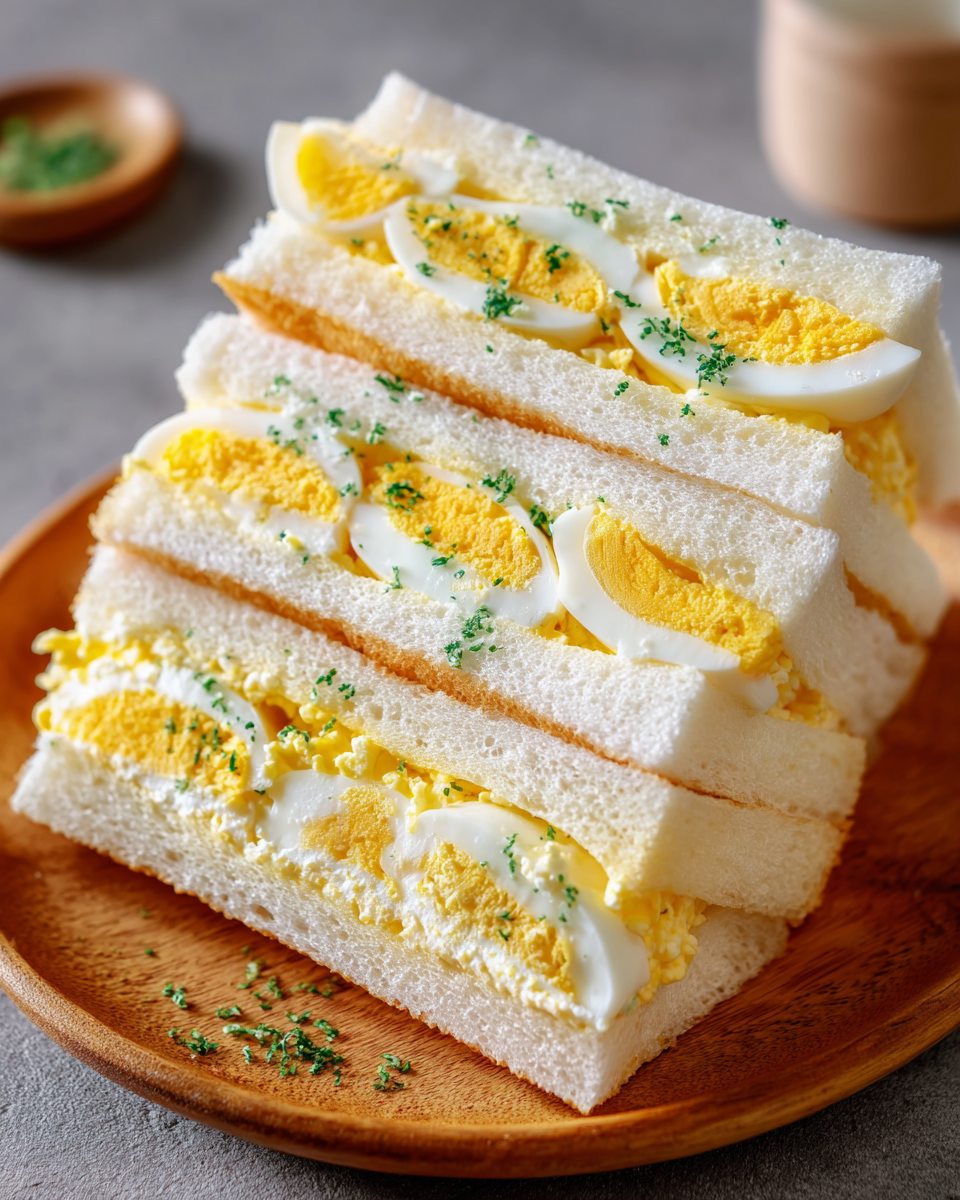The Japanese Egg Sandwich, or Tamago Sando, is a beloved comfort food that perfectly balances simplicity and richness. Made with soft, crustless milk bread and a luxuriously creamy egg filling, it’s a staple in convenience stores and bakeries across Japan. The subtle sweetness of Japanese mayonnaise and the buttery texture of the mashed yolks give this sandwich a melt-in-your-mouth quality that’s hard to resist.
Ideal for breakfast, a quick snack, or packed lunch, this sandwich stands out because of its silky texture and gentle flavors. Its minimalist look belies the depth of flavor inside a humble combination of eggs, mayo, and bread that somehow feels indulgent and nourishing all at once. Tamago Sando proves that with the right ingredients and a thoughtful approach, even the simplest recipes can become iconic.
Full Recipe:
Ingredients:
-
4 slices Japanese milk bread (shokupan)
-
4 large eggs
-
2 tablespoons Japanese mayonnaise (Kewpie preferred)
-
1 teaspoon sugar
-
Salt and pepper to taste
-
Optional: a pinch of MSG or dashi powder for umami boost
-
Butter (for spreading, optional)
Directions:
-
Place the eggs in a saucepan with cold water. Bring to a boil and cook for 9–10 minutes.
-
Transfer boiled eggs into ice water and let them cool completely.
-
Peel the eggs and separate the yolks from the whites. Mash the yolks in a bowl until smooth.
-
Finely chop the egg whites and mix them with the yolks.
-
Add Japanese mayo, sugar, salt, and pepper. Mix until creamy.
-
Lightly butter the bread slices if desired.
-
Spread the egg salad mixture thickly between two slices of bread.
-
Trim crusts and slice the sandwich in half or quarters.
-
Serve chilled or at room temperature.
Prep Time: 10 minutes | Cooking Time: 10 minutes | Total Time: 20 minutes
Kcal: 310 kcal per serving | Servings: 2 sandwiches
When it comes to simplicity paired with elegance in flavor, few sandwiches rival the Japanese Egg Sandwich known in Japan as Tamago Sando. At first glance, it may appear unassuming: pillowy-soft white bread, no crusts, and a generous layer of creamy egg filling. But don’t let its humble appearance deceive you. This beloved Japanese snack is a masterclass in texture, balance, and comfort. It brings together the delicacy of shokupan (Japanese milk bread) and the richness of seasoned, fluffy egg salad, often made with Kewpie mayonnaise. It is a favorite among locals and travelers alike, offering a nostalgic bite that feels like a warm hug.
Let’s explore what makes the Japanese Egg Sandwich so special, how it differs from Western-style egg sandwiches, its cultural significance in Japan, and why it’s become a trend globally among food lovers.
The Essence of Tamago Sando
The magic of Tamago Sando lies in its simplicity and execution. It’s not just a sandwich; it’s an experience. The base is typically shokupan, a thick, soft, and slightly sweet white bread that’s been made with milk, butter, and a touch of sugar. This bread is far softer and more delicate than most Western sandwich breads, which gives the final dish a melt-in-your-mouth quality.
The egg filling is another key to the dish’s charm. Unlike chunkier egg salads in Western cuisine, the Japanese version is finely chopped and often whipped or mashed into a smooth, mousse-like consistency. Japanese mayo, particularly the iconic Kewpie brand, lends a rich umami taste thanks to its egg yolk base and slight tang from rice vinegar. A touch of sugar or even dashi powder may be added for a boost in flavor, depending on preference.
Some elevated versions include soft-boiled eggs in the center, offering an eye-catching “yolk surprise” when the sandwich is cut in half, while others keep it classic with a pure egg salad filling.
Cultural Significance in Japan
Tamago Sando is a staple in Japanese convenience stores (konbini), where it sits alongside other bento box favorites like onigiri and karaage. These convenience store sandwiches are often praised for their surprisingly high quality and affordability. Locals and tourists alike have made them a go-to snack or meal on the move.
Beyond konbini, the sandwich has gained popularity in cafes and bakeries, especially those inspired by kissaten culture traditional Japanese-style coffee houses. These retro cafes often serve thick, crustless sandwiches along with drip coffee and soft lighting, creating a cozy, nostalgic atmosphere.
In Japan, the concept of omotenashi (wholehearted hospitality) is reflected even in its sandwiches. The care taken in preparation, the precision in cutting the sandwich, and the perfect ratio of bread to filling all reflect a cultural value of excellence in even the most ordinary meals.
Why the World Loves It
With the rise of Japanese cuisine globally, it’s no surprise that Tamago Sando has found a fanbase beyond Japan. Food bloggers, chefs, and influencers have embraced this sandwich for its visual appeal and clean yet comforting flavors. It has become a viral favorite on platforms like Instagram and TikTok thanks to its “aesthetic” appearance and the satisfying reveal of the soft yolk center in deluxe versions.
What’s more, Tamago Sando is beginner-friendly. It doesn’t require hard-to-source ingredients or professional cooking skills. Yet, when prepared with attention and care, it can taste like something served at a boutique café.
Its light yet creamy texture appeals to a wide range of palates. It’s also incredibly versatile: perfect for breakfast, a mid-day snack, a lunchbox favorite, or even a comforting late-night bite.
Key Differences from Western Egg Sandwiches
While the core components are similar eggs, bread, and mayonnaise the Japanese Egg Sandwich has distinct differences that set it apart:
- Bread Texture: Shokupan is fluffier, moister, and slightly sweet, unlike the denser, crustier loaves often used in Western sandwiches.
- Filling Consistency: Japanese egg salad tends to be silkier and finer, avoiding large chunks of egg white.
- Seasoning: Kewpie mayonnaise adds depth with its umami-rich flavor, and sugar or dashi powder introduces mild sweetness and complexity.
- Presentation: Crustless and neatly sliced, often diagonally or into perfect rectangles, the sandwich is treated almost like a pastry or dessert in its attention to visual detail.
These differences contribute to the overall experience: it’s not just a meal, it’s a beautifully balanced bite.
Pairing and Serving Ideas
One of the reasons Tamago Sando is so beloved is its adaptability. Here are some delightful ways to serve or pair it:
- With Matcha or Iced Tea: A refreshing green tea pairs perfectly with the sandwich’s creamy richness.
- As Part of a Bento Box: Include it with pickles, fruit slices, or a small salad for a balanced meal.
- As a Picnic Snack: Easy to pack and even easier to eat just wrap them in wax paper for a no-mess solution.
- With Soup: A light miso soup or clear vegetable broth can complement the sandwich beautifully for a cozy meal.
- With a Side Salad: A fresh cucumber or carrot salad with rice vinegar dressing makes for a crunchy, refreshing contrast.
Tips for Making the Best Tamago Sando at Home
- Use Kewpie Mayonnaise: This is essential. Regular mayonnaise won’t give the same rich umami flavor.
- Don’t Overcook the Eggs: Aim for perfectly boiled yolks that are creamy, not chalky. A 9-minute boil followed by an ice bath is ideal.
- Chop and Mash Carefully: Finely chop egg whites and mash yolks separately for that silky consistency before combining.
- Don’t Skip the Sugar: Just a pinch helps balance the richness of the mayo and egg.
- Wrap and Rest: Wrap the assembled sandwich in cling film and let it sit for 10–15 minutes. This helps the flavors meld and makes slicing easier.
Modern Variations to Explore
If you want to add your own twist, here are some variations to experiment with:
- Avocado Tamago Sando: Add mashed avocado to the egg mixture for a creamy, nutritious boost.
- Wasabi Mayo Mix: Mix a tiny amount of wasabi into the mayo for a spicy kick.
- Yolk Bomb Center: Soft-boil an egg and place it whole inside the sandwich so that when you cut it, a bright yolk oozes out.
- Curry Flavored: Add a hint of Japanese curry powder to the filling for a unique flavor twist.
- Vegan Version: Use tofu scramble and vegan mayo to make a plant-based version with a similar creamy texture.
Conclusion: The Art of Simple Perfection
The Japanese Egg Sandwich, or Tamago Sando, is more than just a sandwich it’s a symbol of Japan’s culinary philosophy: mastery through minimalism. By using the finest ingredients and focusing on harmony and detail, this humble dish becomes something extraordinary. Whether enjoyed in a Tokyo café, from a convenience store shelf, or made fresh at home, the experience remains comfortingly consistent.
It reminds us that food doesn’t need to be complex to be delicious. All it takes is care, balance, and a deep appreciation for each component. Tamago Sando is proof that a quiet, softly-spoken sandwich can still leave a loud, lasting impression on your taste buds and your heart.






